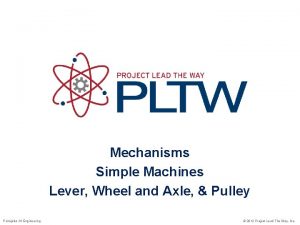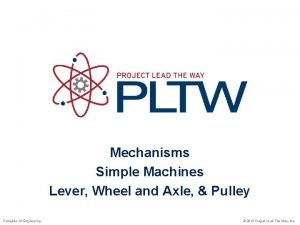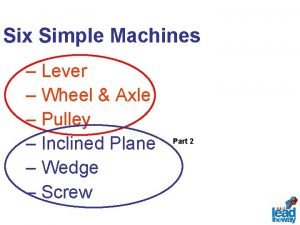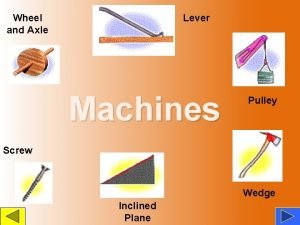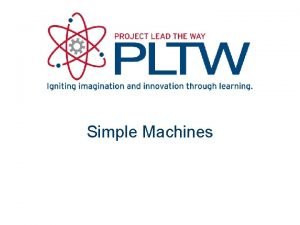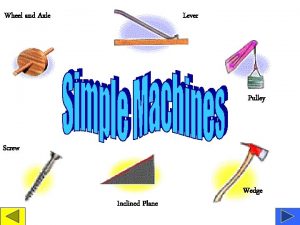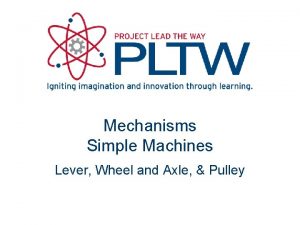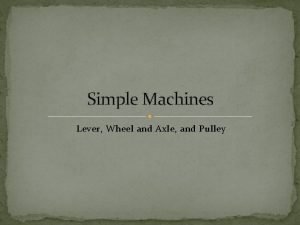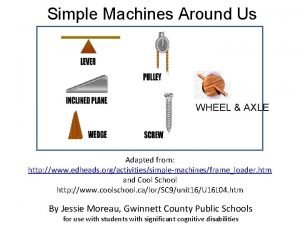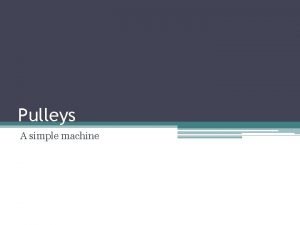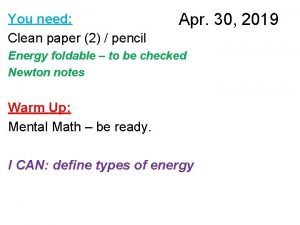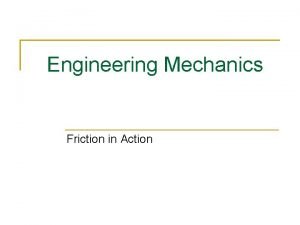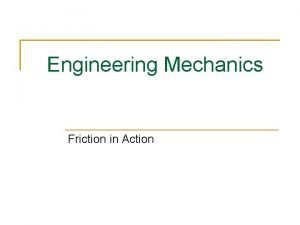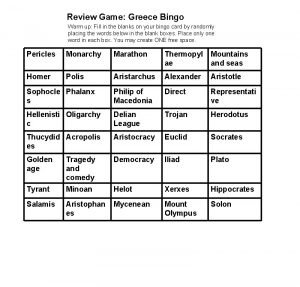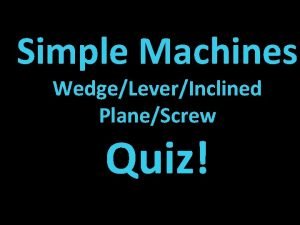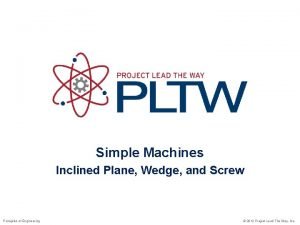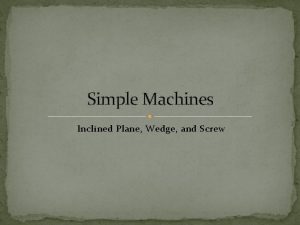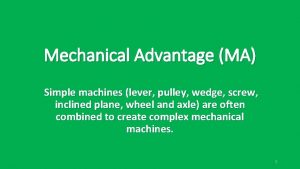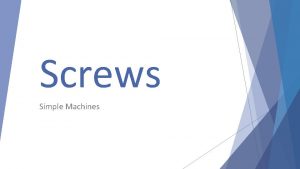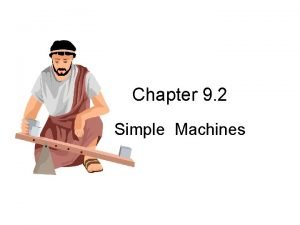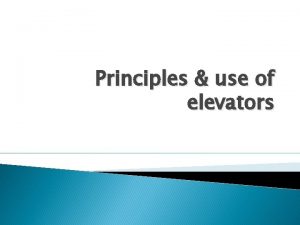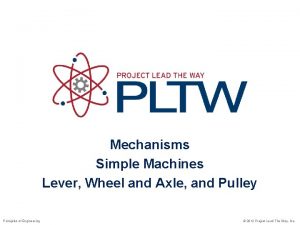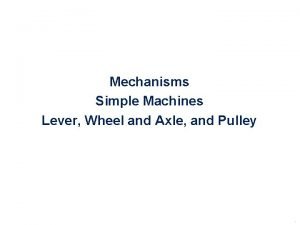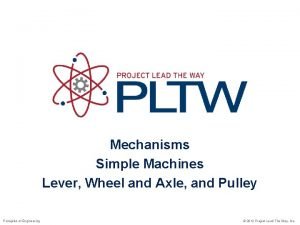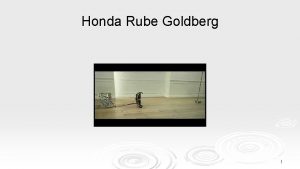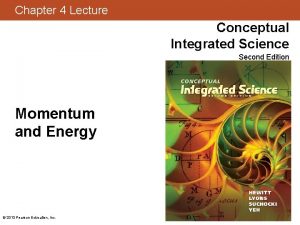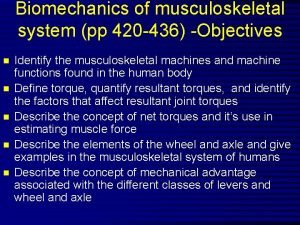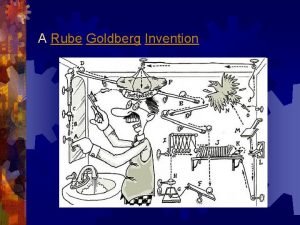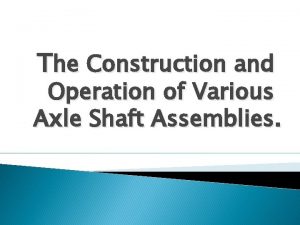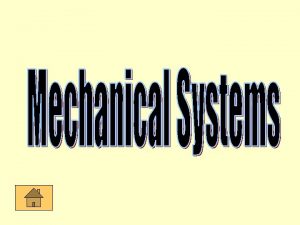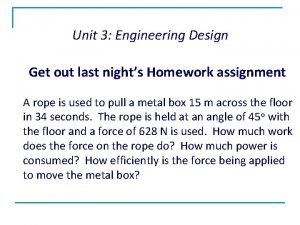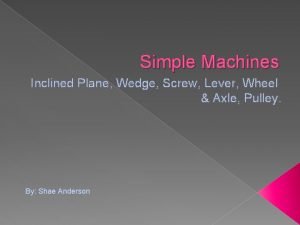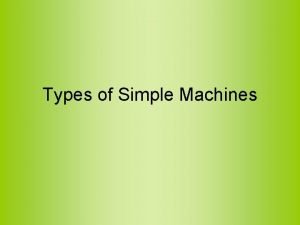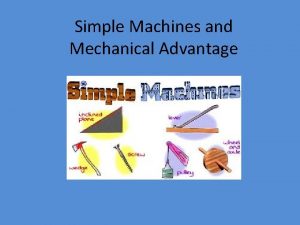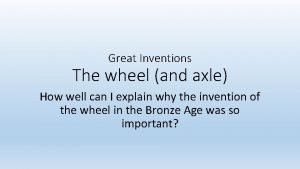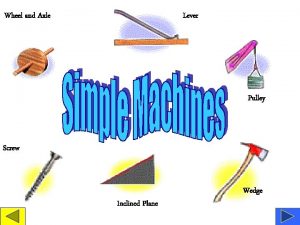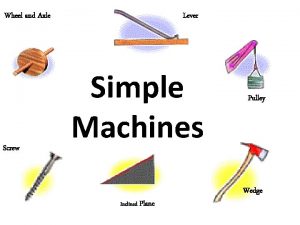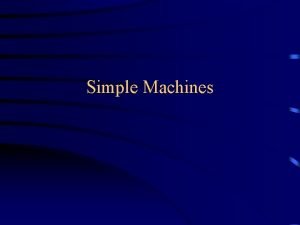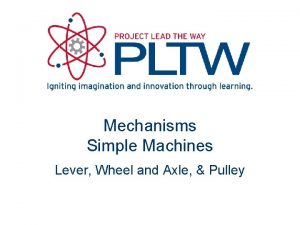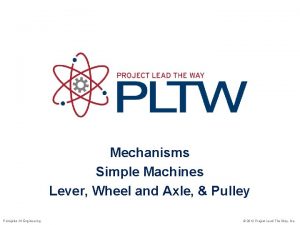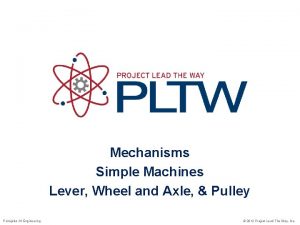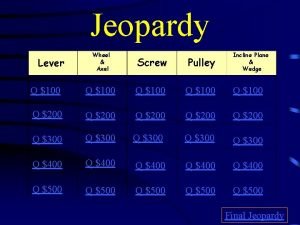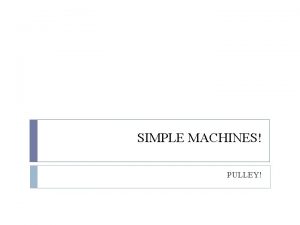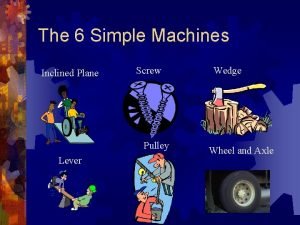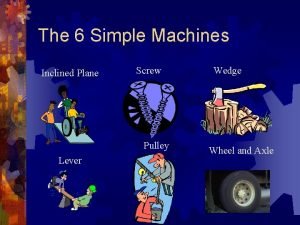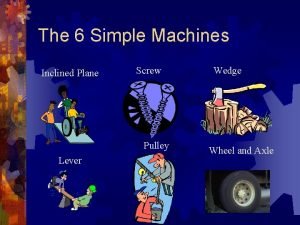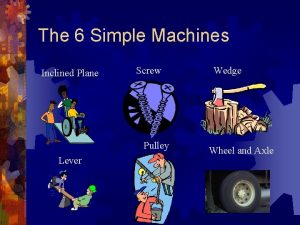Wheel and Axle Lever MACHINES Pulley Screw Inclined




































- Slides: 36

Wheel and Axle Lever MACHINES Pulley Screw Inclined Plane Wedge

SIMPLE MACHINES WHY? • Simple machines are useful because they can make a physical job easier by changing the magnitude or the direction of the force exerted to do work.

Have you ever tried to unscrew a nut, bolt, or screw from something with your bare hands and discovered that it was just too tight to loosen even if you had a good grip?


You got the proper tool, such as a screw driver or wrench, and unscrewed it!

Why is it that it is so easy to unscrew with a tool when you can't with your bare hands?

The wrench and screw driver are examples of a wheel and axle, where the screw or bolt is the axle and the handle is the wheel. The tool makes the job easier by changing the amount of the force you exert. Wheel Axle

All of the simple machines can be used for thousands of jobs from lifting a 500 -pound weight to making a boat go. The reason why these machines are so special is because they make difficult tasks much easier.


• A sloping surface, like a ramp, that reduces the amount of force needed to lift something by increasing the distance over which the force is applied. • In other words, it reduces the amount of force needed.

EXAMPLES

MECHANICAL ADVANTAGE THE INCLINED PLANE – Reduces the amount of force by: – Increasing the distance over which the force is applied. – As the ramp is made longer and less steep, less force is required.

• An inclined plane wrapped in a spiral around a cylindrical post. • As you turn the screw, the threads pull the screw into the wood. • The inclined plane slides through the wood.

EXAMPLES

• An inclined plane with one or two sloping sides. • Two inclined planes make a wedge. • Wedges change the direction of the force.

EXAMPLES

• A bar that is free to pivot or turn around a fixed point. Lever Load Fulcrum – fixed point

LEVERS

LEVERS There are three classes of levers and each is based on the position of the fulcrum.

st 1 CLass Examples: Crowbars, pliers, scissors, seesaw The fulcrum is between the resistance force and the effort force. The closer the fulcrum to the resistance force, the more the lever multiplies the force.

nd 2 Class • Wheelbarrow • Nutcrackers • Crowbar (forcing two objects apart) • The handle of a pair of nail clippers 2 nd Class: The resistance force is between the effort force and the fulcrum.

rd 3 Class 3 rd Class: the effort force is between the resistance force and the fulcrum. • Garden Hoe • Your arm • Catapult • Fishing rod • Tongs (double lever) (where hinged at one end)

CLASSES OF LEVERS First Class Fulcrum is between Fe and Fr Second Class Fr is between the Fe and fulcrum Third Class Fe is between the Fr and the fulcrum

MECHANICAL ADVANTAGE LEVER – Makes work easier by: – Multiplying your effort force and changing the direction of your force

LEVERS

A grooved wheel with a rope, chain, or cable running along the grove. Wheel Rope The two sides of the pulley are the effort arm and the resistance arm.

FIXED PULLEY • A modified first class lever; the axle of the pulley acts as the fulcrum. • Cannot multiply the effort force, ONLY changes the direction of the effort force.

MOVEABLE PULLEY • One end of the rope is fixed and the pulley or wheel is free to move • Can multiply the effort force and change the direction of the effort force. • Because effort force increases, the distance must increase to conserve energy. You pull more. Pulleys

EXAMPLES

A machine consisting of two wheels of different sizes that rotate together. Wheel Axle

WHEEL AND AXLE • Usually the effort is exerted on the larger wheel. Then the smaller wheel (axle) exerts the resistance force. • A modified lever.

EXAMPLES

MECHANICAL ADVANTAGE WHEEL AND AXLE – The effort arm is the radius of the wheel – The resistance arm is the radius of the axle – The mechanical advantage of a wheel and axle can be increased by making the radius of the wheel larger.

COMPOUND MACHINES • When two or more simple machines are used together. • The overall MA of the compound machine is related to the MA of all the machines involved.

EXAMPLES

 How to find the total ima of a compound machine
How to find the total ima of a compound machine Ama of a pulley
Ama of a pulley Leb
Leb Screw machine example
Screw machine example Pulley wheel and axle
Pulley wheel and axle Inclined plane and lever
Inclined plane and lever Wheel and axle formula
Wheel and axle formula Ama of a lever
Ama of a lever Examples wheel and axle
Examples wheel and axle Wheel and axle examples around the house
Wheel and axle examples around the house Uses pulley
Uses pulley Pulley and screw
Pulley and screw A flat belt connects pulley a to pulley b
A flat belt connects pulley a to pulley b A flat belt connects pulley a to pulley b
A flat belt connects pulley a to pulley b Mastered the use of the lever and pulley
Mastered the use of the lever and pulley Planescrew
Planescrew Ima of a screw
Ima of a screw Wedge and inclined plane
Wedge and inclined plane Mechanical advantage of a wedge
Mechanical advantage of a wedge Pulley simple machine
Pulley simple machine Sample of screw
Sample of screw 6 simple machines examples
6 simple machines examples Prying motion elevator
Prying motion elevator Wheel and axel ima
Wheel and axel ima Wheel and axle ima formula
Wheel and axle ima formula Lever ima
Lever ima Rube goldberg wheel and axle
Rube goldberg wheel and axle Which machine has the greatest output force? a b c d
Which machine has the greatest output force? a b c d Pulley system in biomechanics
Pulley system in biomechanics Rube goldberg wheel and axle
Rube goldberg wheel and axle Wheel and axle construction
Wheel and axle construction Simple machines formulas
Simple machines formulas Wheel and axle
Wheel and axle ворот механизм
ворот механизм Simple machines lever
Simple machines lever Advantage of using simple machine
Advantage of using simple machine Wheel and axle well
Wheel and axle well
